Final report for FNE16-842
Project Information
This project aimed to explore the potential benefits of multi-species grazing of sheep with ducks in order to address the parasite Parelaphostrongylus tenuis (P. tenuis, a.k.a brain worm/deer worm). This parasite's normal host is deer and then slugs/snails pick up infective vectors from deer manure and become intermediary hosts before affecting sheep or goats that eat the snails/slugs or slime on the litter. Since sheep and goats are not normal hosts, infection often leads to paralysis and death of the affected sheep or goat. In the past, we’ve demonstrated that ducks can reduce slug populations that are a pest to shiitake mushroom production (Project FNE12-745).
In order to monitor slug populations in 2017, we distributed traps made from soda bottles in 10 locations in each paddock, roughly 50 feet apart. We filled the trap with about 1 – 2″ of fresh beer. We monitored traps twice each week in 2017 ad 2018, counting slugs captured and also emptying and refilling with fresh beer, an important practice to ensure the traps would continue to attract slugs. A basic count of the total slugs was taken per paddock and recorded. We tracked these figures from June 19 through October 13 a total of about 17 weeks of study. We also looked at variables including precipitation and grass height. We were able to acheive some notable affect of grazing ducks on slug populations.
In summary, we can suggest a few important points and lessons learned that we think other farmers can benefit from:
- Slug population dynamics are highly variable, and cannot be predicted using the month of the year, precipitation, or height of grass in a paddock. They rise and fall throughout the season dramatically.
- In springtime and early summer, slug populations may be significantly higher than during the rest of the growing season, which potentially increases grazing ruminant exposure. Avoid the wettest grazing sites in early spring. Consider this as a place to target with ducks if it’s easy to do without extra effort.
- Monitoring for slug population dynamics is difficult, and not a feasible task for most farms to undertake in a way that will provide clear directives for action.
- Ducks DO reduce slug populations – but likely not for long periods of time.
- A holistic approach to reducing parasite impacts on grazing animals suggests that ducks could play a role in slug control, but are not a reliable method to replace breeding for resistance, including high tannin forages in an animals diet, and other methods.
We have concluded that while some short-term impact/benefit can occur on slug populations from duck grazing activity, it may not be enough to justify the labor and time to monitor populations, coordinate moving them into the right place at the right time, all with special effort just to realize a benefit on reducing parasites.
In other words, if you are in a situation where you have ducks and are rotating them, you might receive some secondary benefits of running them through pasture, but its not worth going out of your way. This conclusion is not due to the fact that ducks aren’t inherently effective at reducing slug populations. It’s more about the challenges of varying dynamics, timing, and labor that make the prospect challenging.
Our goals for the project were to:
Objective 1: Determine if grazing 50 ducks reduces gastropod populations in half acre paddocks
Objective 2: Reduce brain worm parasite risk to grazing ruminants, thereby reducing the need for Ivomec, dexamethasone, and Safeguard
Objective 3: Determine ideal timing of leader-follower rotation that results in low gastropod population, minimal duck poop presence on pasture, and diverse and abundant forage
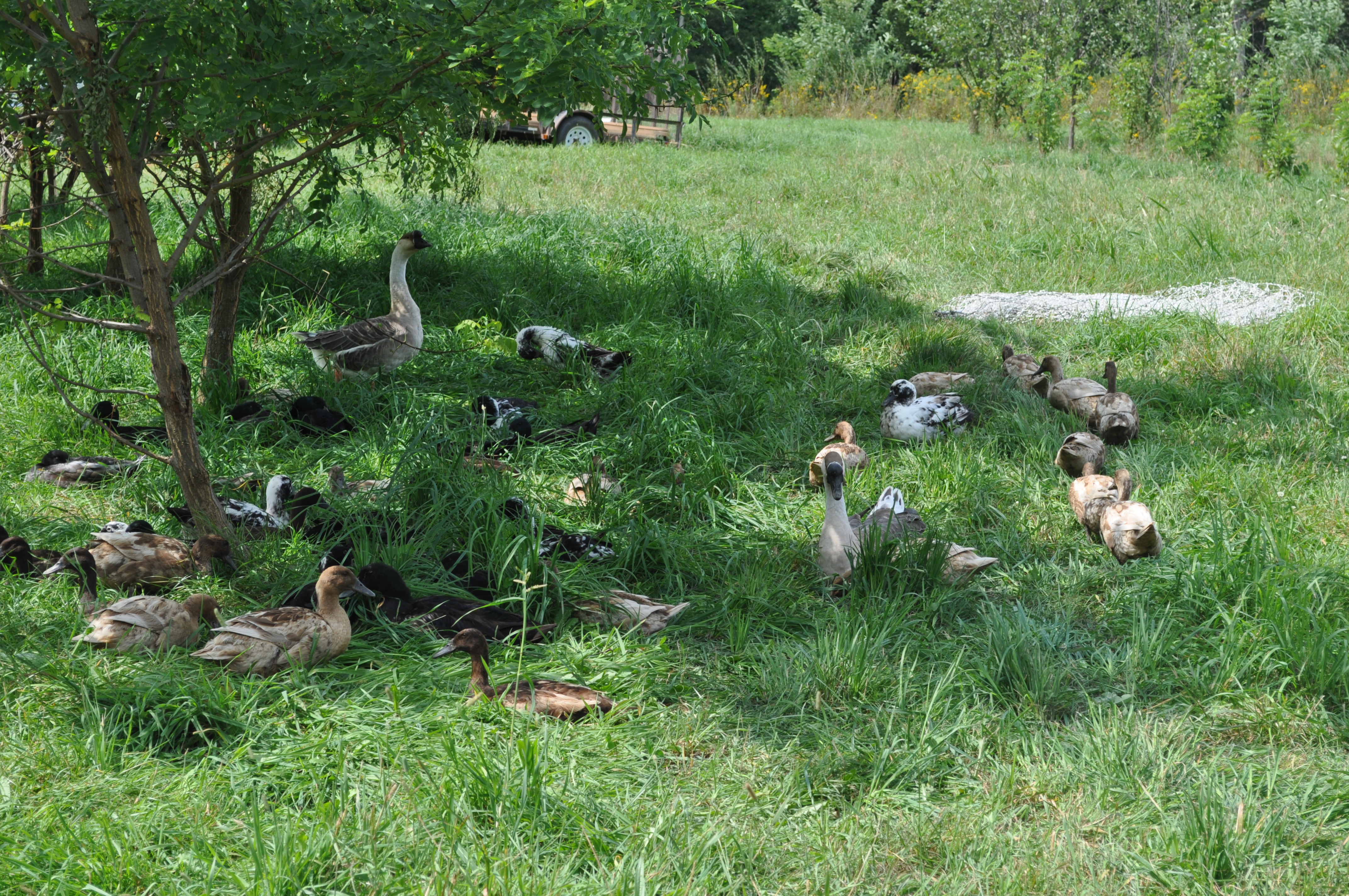
Wellspring Forest Farm is a 50-acre agroforestry inspired farm and homestead. The farm is co-owned and operated by Elizabeth and Steve Gabriel and we’ve been growing crops since 2011. We develop our operations systematically, analyzing resources and challenges of the site, our economic capacity, time, personal interest and market demands. We value that agroforestry offers opportunities for restoring the ecological health of the land while providing income for the farm.
Our main crop is mushrooms, which we sell to restaurants and through a CSA. We maintain a flock of 50 ducks that provide slug control to the shiitakes and nutrients to our gardens. We originally brought ducks onto the farm as a meat enterprise but determined that eggs would fit better with our goals long term. We sell eggs to local retail stores and restaurants. Since 2012, we have planted trees to eventually provide wind protection, fodder, shade and wood for our grazing sheep.
Sheep complemented the operation because our pasture is in need of regeneration and sheep are much more sustainable than mowing between the rows of tree crops. We expect to have around 28 sheep in 2016 and have a goal of managing about 20 ewes and 30 lambs each year from 2018 onward. Adding ducks to the sheep rotation, we hope further improve soil health, reduce sheep exposure to parasites and increase farm production.
This proposal focuses on Parelaphostrongylus tenuis (P. tenuis, a.k.a brain worm/deer worm). This parasite is on the rise and is especially problematic because there is no effective treatment plan with a strong likelihood of full recovery.
P. tenuis larvae are excreted in deer feces, common grazers of pasture. Larvae infect gastropods, which are consumed by ruminants. Just one larva in a sheep’s spinal cord can cause illness. The life cycle of land snails or slugs is mostly sexual reproducion followed by egg laying. The eggs take about one month to develop to an adult and the adults can live more than one year, hibernating in the witner. There is no method for monitoring P. tenuis – producers can only act once an animal shows clinical signs of infection. Anthelmintics and corticosteroids (Ivomec, dexamethasone, Safeguard) can treat the parasite, but have varying effectiveness and don’t meet organic standards. Despite treatment, some animals die or become permanently lame. Rarely is there full recovery. There is no way to predict the outcome.
This project built off our previous research (FNE12-745) where we determined best practices for utilizing ducks to control slugs in our log-grown shiitake enterprise. We are mostly interested in having ducks on the farm for this pest control benefit, but have also found a modest income from egg sales. Our success with ducks in the mushroom enterprise and anecdotally in our gardens and orchard systems has led us to see their benefit to many systems. Moving them into the sheep rotation may be beneficial, but there is likely an issue with getting the proper timing down to have efficacy. Our main question; is it worth rotating the ducks in sheep paddocks to reduce the slug population and thereby reducing our sheep flock's exposure to parasites?
The focus of this project sought to draw out the potential benefits of having animals on a landscape that, while not turning a huge profit, contribute to supporting the profitability of other more lucrative enterprises. In this case, our log-grown shiitake and pastured sheep enterprises are the most profitable systems on the farm, while ducks are a harder prospect from a profit standpoint. The cost of production for eggs, along with consumers expecting eggs to be cheap, means that there are very thin margins in egg production. Our goal has been to sell eggs in order to cover the cost of raising the ducks - from an inputs and labor standpoint. We could therefore benefit from the ecosystems services the ducks provide, produce our own eggs for consumption, and not have to pay for it.
To us, this is an important aspect of modern US farms. In recent times, the focus for farm production has been almost exclusively for market production, which means certain systems get left out of the business, whether they provide benefits or not. It wasn't so long ago that most family farms in the US balanced production for home, family, and community at a small scale with an additional selection of "cash crops" to provide money to the farm. We have found high value in mixing systems that produce goods at a smaller scale and fit well as a complement to those we focus more on a cash return. The ducks, our orchards, and vegetable production all fit into this "homestead" category, while we produce mushrooms, pastured lamb, maple syrup, and elderberry more for commercial markets.
Cooperators
Research
Due to the historic D3 drought in our region during the 2016 grazing season, we opted to delay the start of monitoring slug populations to the 2017 and 2018 seasons. Our past experience meant we knew the work would produce less than valuable results, because slug populations are virtually non-existent during dry times. Additionally, the drought conditions meant that pasture did not grow after the sheep’s first rotation in May. We spent 2016 reorganizing our grazing system to accommodate drought and make use of hedgerows, which will help tremendously as we set out to collect data over the next two seasons.
We realized as we planned for the 2017 season that starting to rotate ducks into paddocks would not be useful without first establishing baseline data for each paddock, since it cannot be assumed that slug populations are the same for each location, nor do they stay consistent with the seasonal changes in weather patterns.
If we started integrating ducks right away, we might observe differences in control vs. treatment paddocks that we would attribute to duck activity, when the variability may in fact be due to other factors. The main factors we believe affect the presence of slugs in paddocks include 1) recent weather, especially precipitation, 2) length of the grass, 3) previous impacts on slug populations
Therefore, we decided that in 2017 we would collect slug population data and track our sheep grazing, as we might normally do. We could then look and see if there are any trends in slug populations, any differences among paddocks, and any correlation with weather events.

In order to monitor slug populations in 2017, we distributed traps made from soda bottles (see figure 1.1) in 10 locations in each paddock, roughly 50 feet apart. Each trap was sunk into the ground using a bulb digging tool and set so that the opening of the trap sits at ground level. We filled the trap with about 1 - 2" of fresh beer. The map (see figure 1.2) of these trap shows we aimed for a relatively even distribution of traps, though there is some variability in the shape of the paddock. We selected the paddocks in the wettest locations closest to the woods edge, as we assume these are more likely to have slugs (intermediate host) and also deer visiting the pasture, who are the origin host for the parasite in question.
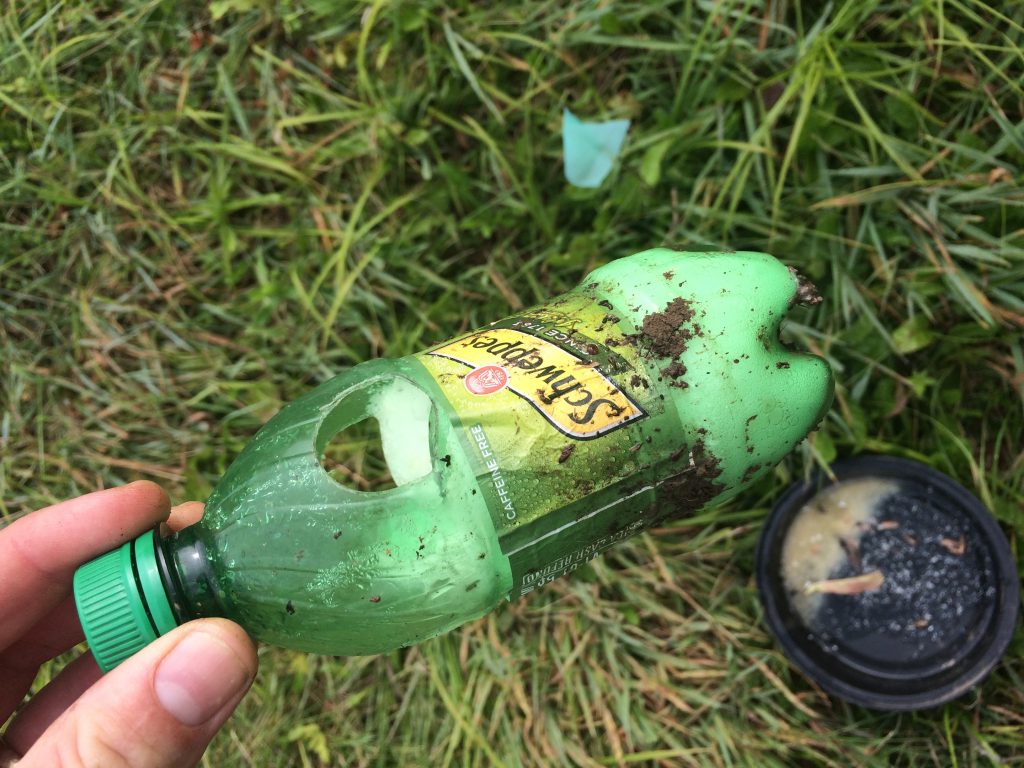
We monitored traps twice each week in 2017 ad 2018, counting slugs captured and also emptying and refilling with fresh beer, an important practice to ensure the traps would continue to attract slugs. A basic count of the total slugs was taken per paddock and recorded. We tracked these figures from June 19 through October 13 a total of about 17 weeks of study.
Big thanks to Jonathan, Shaun, Claire, Cat, Carly, and Chad, our on-farm helpers in 2017 and 2018, who were awesome and stayed positive even while counting slugs!
As the graph below shows for the year 2017, results of the data collected indicate there will be some consistency to the pattern of slug presence among the collection of paddocks selected for this study. This is useful as we attempt to add ducks to 3 of the paddocks in 2018, to see if we can affect populations. If successful, those paddocks would hopefully deviate from the overall trends.
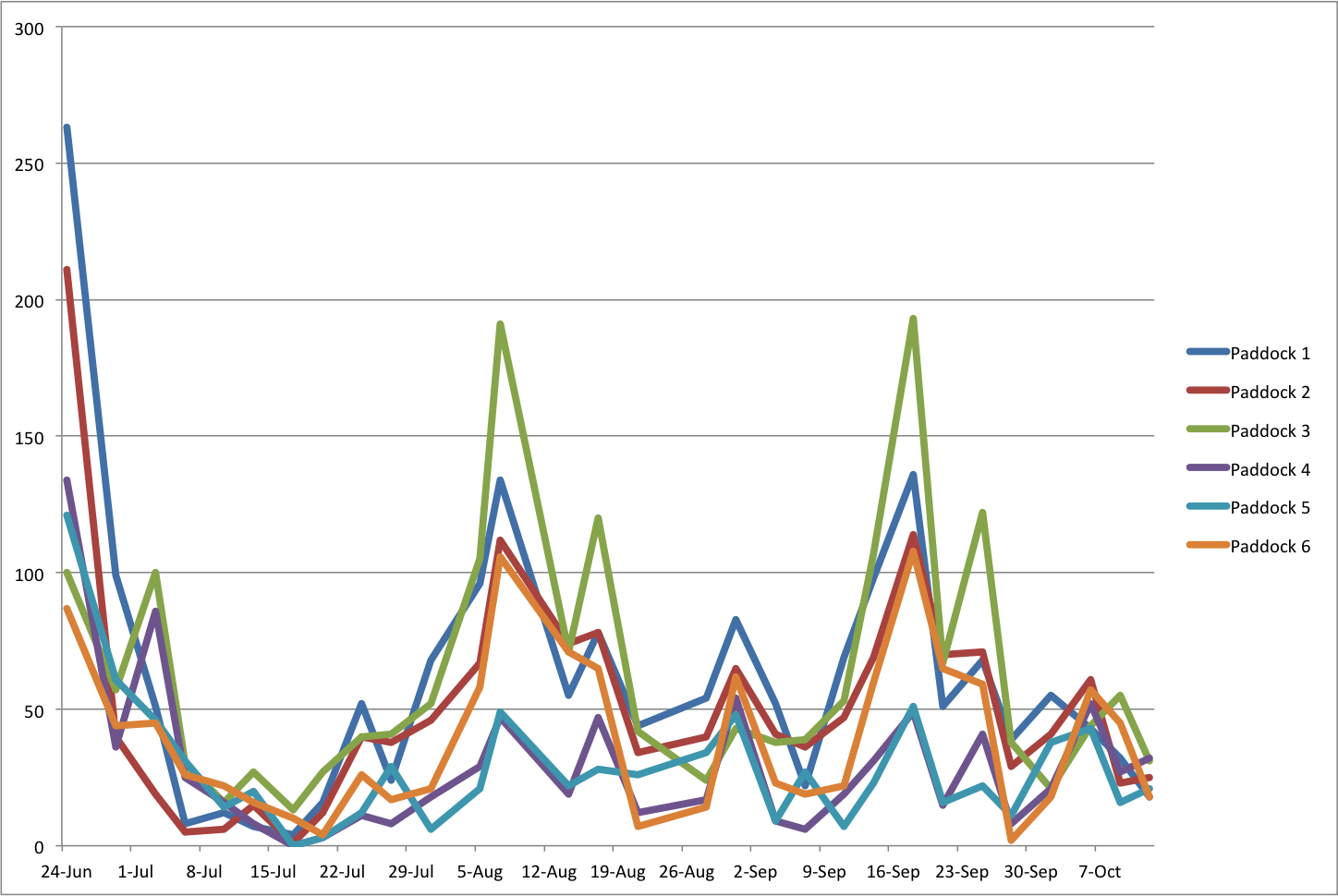
When comparing this graph to local precipitation data for the same timeframe, there is not a clear correlation between anything happening with precipitation and a "response" from slug populations:
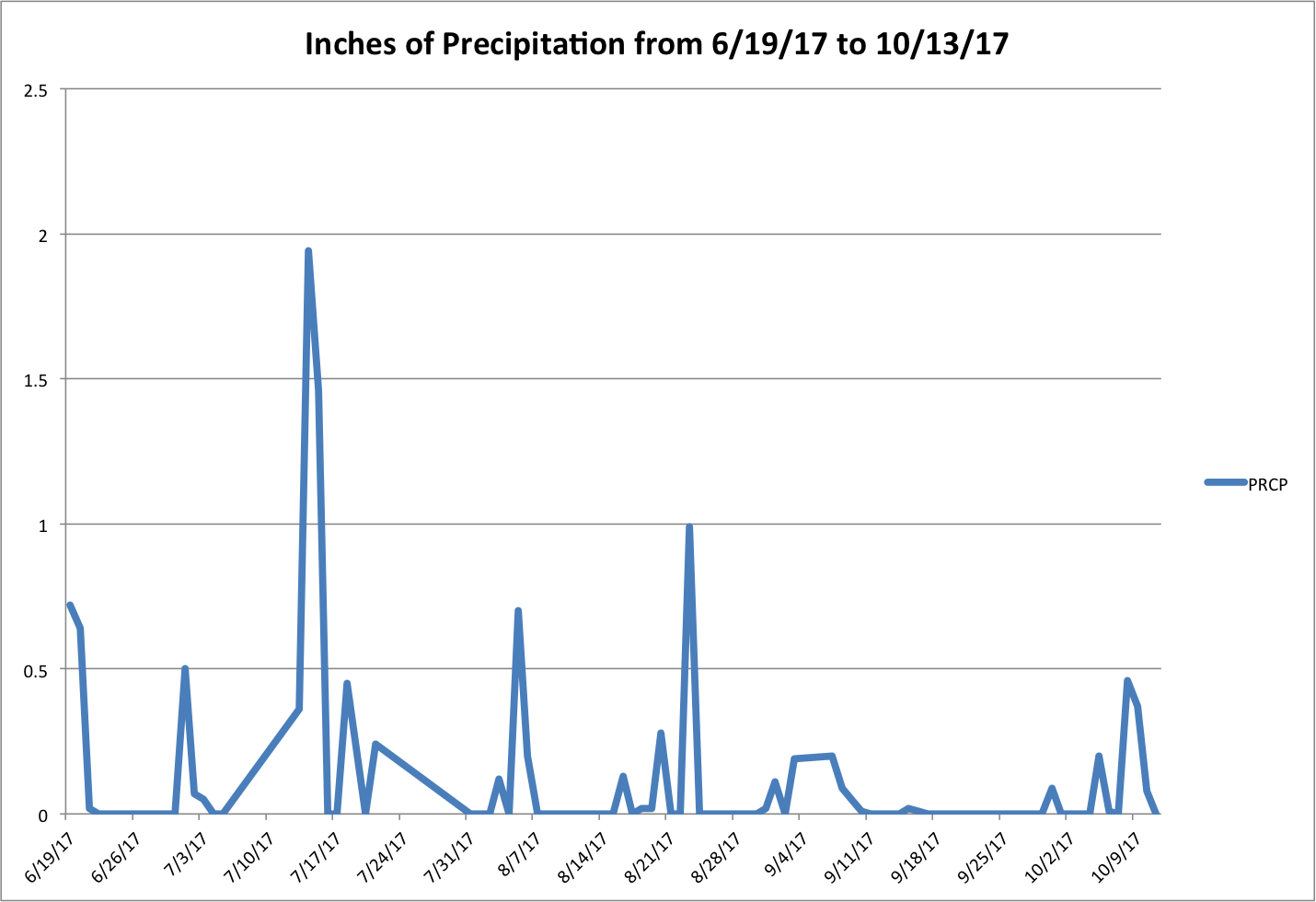
We were ready to proceed to the treatment portion of the research in 2018, and will better track grazing in the paddocks, as well as grass height, as we are curious if this has any effect on slug presence. We will accomplish this by measuring the average height as we take slug counts. Our theory is that less grass = more drying out, which could have an effect.
2018 Results
For the second year, the goal was to track the changing dynamics of slug populations in the same paddocks, as well as attempt to implement the "treatments" - that is, a roughly week long residency of the ducks in 3 our of the 6 paddocks, to see if there was any impact they offered to reduce slug populations. While as previously mentioned we delayed the start of this projects in 2016 because of historic drought, 2018 was notably wet, after a normal/dry May and June. The months of July, August, and September each were 2 - 3 inches more rainfall than normal (almost double the amount) and for the year we are 10 - 15 inches over normal rainfall. This is important to mention from the outset, as the rain likely affected our data, since excessive rainfall was found to flood the traps on several occasions, which dilutes the beer and effectively suppresses the yeasts that attract the slugs.
That said, our overall slug counts were reasonably aligned with those of 2017, at least in terms of showing the high variability and change that naturally occurs in slug populations, as shown in the graph of counts for the 2018 season:
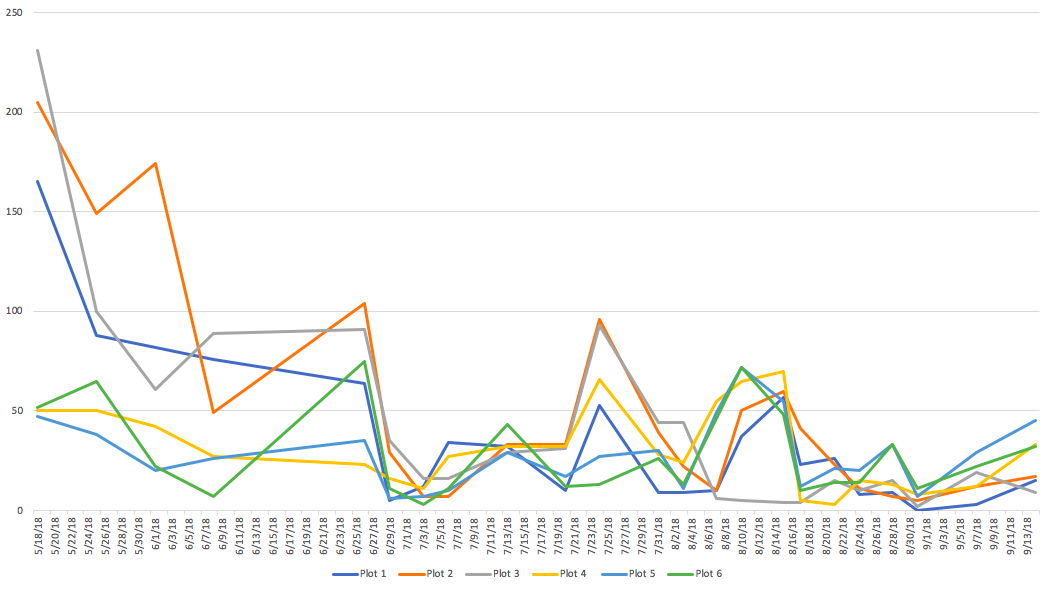
There are two notable patterns when comparing both years that are useful. One is that in both seasons, the highest slug counts were in the spring, though we started counting in late June in 2017, and mid May in 2018. Regardless, in both seasons, the relatively high counts dropped below 100 per paddock by early July, and never returned to the spring and early summertime high points.
The other relevant pattern is that... there isn't really a consistent pattern. Rates are not consistent or constant, but rather ebb and flow. As noted in 2017, rainfall wasn't a reliable indicator of these dynamics, and in 2018 we looked at grass height, where we also found that the height of the grass didn't prove to be a helpful indicator of slug levels, either, as noted from a few sample paddock data sets. For some paddocks, we even intentionally let the grass grow very high (see paddock 3) to see if there was any effect - and there was no clear correlation.
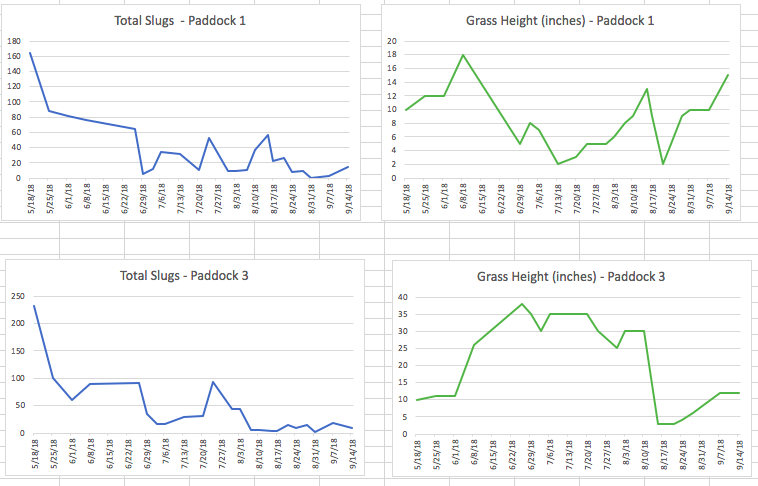
While we had hoped to do two visits of the ducks to each of the three treatment paddocks (for six total treatments), because of the heavy rainfall and persistently wet soils, we were only able to do one set (three treatments). Our duck house, small tractor, slopes, and mucky soils led to many issues early in the season.
Before doing a treatment, we were also looking for a data set with a good high number of slugs in each paddock, because we figured if one or two paddocks had a low reading, it would be hard to see any dramatic effect the ducks might have. In retrospect, we missed our best window of opportunity in May, when counts were very high. We then had a lot of variability in June through mid July, and finally decided to just give it a try when we took our 7/24/18 readings and saw some reasonably high numbers of slug counts across the board (in light orange below):
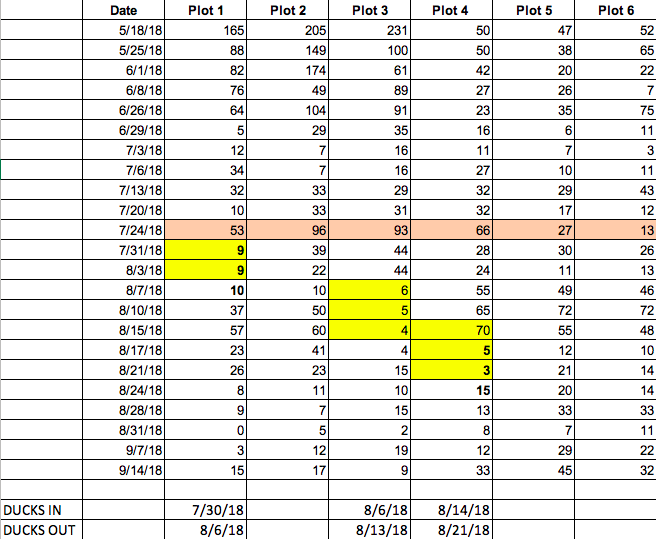
The yellow blocks indicate samples that took place during the residency of the ducks in one of the treatment paddocks (1, 3, or 4). Each paddock was randomly selected from the entire sample group as the treatment areas. We attempted to sample as consistently as possible on a weekly basis, sometimes taking an additional sampling point during the season because of the rain affecting the viability of the slug traps. Perhaps the biggest takeaway from this project is how hard it is to track slug population dynamics, given all the variables at play.
During the treatment weeks, our ducks were brought in and kept in the space for approximately one week. If we zoom into this period of time and compare the results between the control paddocks and the treatment, one interesting pattern emerged:
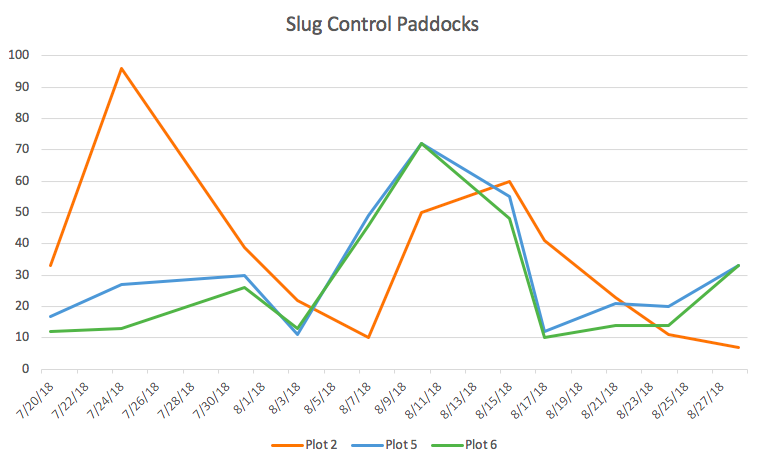
While the plots above show the characteristic rise and fall we see as a large pattern, the treatment paddocks had a noticeable flatlining of the counts during the residency period, though for widely differing durations. The flat line persisted in paddock 1 for seven days, versus ten days in paddock 3, and just four days in paddock 4. The arrows indicate how long the ducks were in each paddock:
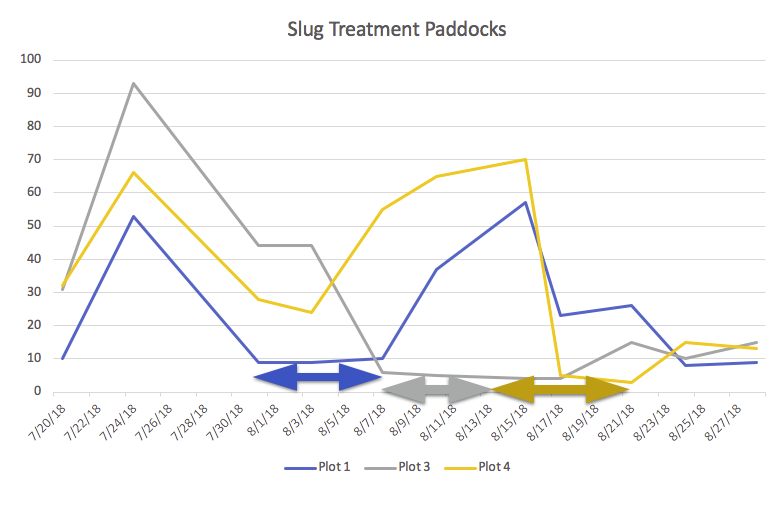
Notable also is that in all cases, slug levels were already in decline for each treatment before the ducks arrived. But when we compare to the larger picture of all paddocks, we do see some indication of effect. With the first treatment (blue), all other paddocks rose, while paddock 1 stayed flat for a longer period. For the second treatment (gray), all other paddocks were on a sharp upward trend, while paddock 3 remained low. For the third treatment (yellow), all paddocks were on the decline, but started to rise again, whereas paddock 4 lagged a bit further behind:
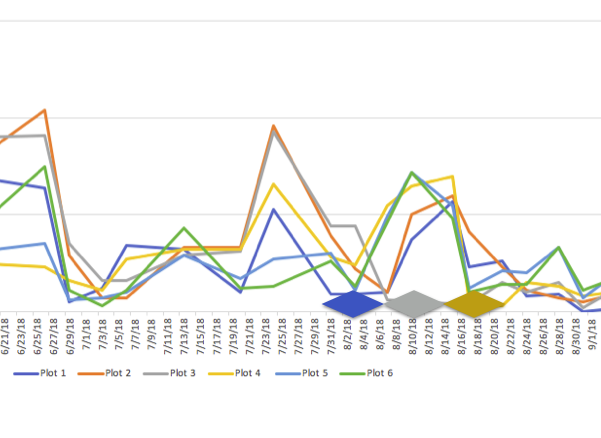
Important to note is that while some effect was seen above from duck activity, it was not particularly long lasting. In all three cases, in just a few days after the ducks left the paddock, the slug numbers generally rejoined the overall pattern of population dynamics across all of the paddocks.
Since the pastures also clearly needed some rest and recovery time post-duck before sheep could graze, this approach doesn't seem to be particularity effective when taking in the larger context of our goal, which was to reduce exposure of our sheep to parasites. We found that a paddock needed 7 - 10 days of rest before the pasture was just grazeable, and thus by the time the sheep arrived there would be little benefit of any substantial reduction in slugs.
Given this result, and the amount of labor it took to monitor slug population dynamics, and the high variability within the 10 traps in each paddock, there is a larger question about the practicality of this on a farmer level.
Even if we could replicate this trial and get better results, could farmers easily decide if and when to put ducks into a rotation in a way that might offer clear benefits to their grazing animals? Since weather, precipitation, grass height, and overall slug population dynamics act independently of each other, there seems to be little benefit in attempting to utilize ducks in this way. Knowing there IS benefit to the presence of ducks, however, is useful. We just don't see a way to plan or control the affect in a way that is time effective.
Its notable that in two seasons, the population of slugs were significantly higher in the spring and early summer months. Also important is that for both seasons, the really high numbers were in paddocks 1, 2, and 3, which are situated lower in our landscape, border a creek, and often have wetter soils that take longer to dry out. Paddocks 4, 5, and 6 were higher in the landscape and dried out sooner. As an aside, we had two sheep contract P tenuis during the grant duration but we can in now way correlate those incidents to the presence or absence of ducks.
So, there may be benefit of putting ducks through the pasture in early Spring to reduce the overall slug populations, which could reduce their ability to reproduce. This is the general approach we concluded from our last grant, where we more effectively utilized ducks to control slugs in our woodland shiitake mushroom operation (https://projects.sare.org/sare_project/fne12-745/). The major difference is that its easy visually to see the effect of ducks clearing out slugs on our mushroom crop, but harder to measure the efficacy in pasture, since its literally harder to see the slugs, as well as monitor any effects on the "crop"- i.e. if the sheep are ingesting them (versus the slug damage visible with the mushrooms).
We have concluded that while some short term impact/benefit can occur on slug populations from duck grazing activity, it may not be enough to justify the labor and time to monitor populations, coordinate moving them into the right place at the right time, all with special effort just to realize a benefit on reducing parasites. In other words, if you are in a situation where you have ducks and are rotating them, you might receive some secondary benefits of running them through pasture, but its not worth going out of your way. This conclusion is not due to the fact that ducks aren't inherently effective at reducing slug populations. It's more about the challenges of varying dynamics, timing, and labor that make the prospect challenging.
This funding demonstrates the reality of trying to solve an on farm problem by managing a complex ecological dynamic. At the end of the day, this idea would just be one more way to reduce parasite impact on our grazing sheep, along with breeding and selection practices to favor resistance, and the inclusion of high-tannin forages in their diet to reduce the effects of parasite build up. We are proceeding in this multi-faceted approach, and will target duck activity in our wettest pastures, and especially in early spring time.
To revisit our original objectives one and two, we sought to assess if ducks could reduce slug populations meaningfully in a rotational grazing system. We found that, while we can potentially reduce a population in a given paddock, the effect is not one that lasts, and is therefore impractical as a meaningful activity to attempt.
As with any research project, more years and subsequent trials could further improve on the methods and attempt more treatments, which could offer better results. Its very time consuming to measure and refill traps on a more than weekly basis; and it was impossible to do every 2 - 3 days as would be ideal, given that the beer wears out.
Should we have found that ducks were effective, objective three was then to figure out a feasible leader-follower rotation for ducks and sheep. Since the duration of any effect is so short, this objective was not able to be met, since we'd need a longer recovery of the forages before getting the sheep on them, when slug populations would potentially be back to more "normal" levels.
In summary, we can suggest a few important points and lessons learned that we think other farmers can benefit from:
- Slug population dynamics are highly variable, and cannot be predicted using the month of the year, precipitation, or height of grass in a paddock. They rise and fall throughout the season dramatically.
- In springtime and early summer, slug populations may be significantly higher than during the rest of the growing season, which potentially increases grazing ruminant exposure. Avoid the wettest grazing sites in early spring. Consider this as a place to target with ducks if it's easy to do without extra effort.
- Monitoring for slug population dynamics is difficult, and not a feasible task for most farms to undertake in a way that will provide clear directives for action.
- Ducks DO reduce slug populations - but likely not for long periods of time.
- A holistic approach to reducing parasite impacts on grazing animals suggests that ducks could play a role in slug control, but are not a reliable method to replace breeding for resistance, including high tannin forages in an animals diet, and other methods.
Education & Outreach Activities and Participation Summary
Participation Summary:
TOURS:
Permaculture Site Tours in August (2016, 2017, 2018) with average of 75 visitors per year.
CCE Tompkins Farm Days (July 2017) with 25 visitors.
For the Love of Duck! talk at NOFA-NY Conference, January 2017 with 30 participants. Ducks_NOFANY2017
Growing a Woodland Farm and Homestead Three day Workshop (June 2017 and 2018) with 15 and 20 participants, respectively.
Silvopasture in Practice Three Day Workshop, October 2018 with 22 participants.
Silvopasture in Practice intensives at NOFA-VT and PASA Conferences, Winter 2018 (28 and 46 participants, respectively.)
Raising Ducks talk, 2018 PASA, with 40 participants
Silvopasture in Practice talk Midwest Organic Farming Conference, Feb 2019 (209 participants)
Learning Outcomes
We will be offering an educational webinar in early 2019 and are completing and reformatting our guide book to be published before the project terms in March, will update this section during our final report.
Project Outcomes
Outcomes include:
- Better understanding of the complex dynamics of pest (slug) cycles in pasture
- Appreciation for the role ducks can play in reducing impact, despite the challenges from a management standpoint
As a result of the project, we will be rotating our ducks through pasture, though as part of our regular movements, and not in relation to any sort of monitoring for slug numbers. We will target their impact in the wettest pastures in early spring and summer, when slug counts appear to be highest.
We can attest after having done two grants attempting to quantify slug activity that the work is neither easy, nor enjoyable. Emptying traps and counting drowned slugs isn't enjoyable for anyone. Yet, we appreciate being able to look at the results of this consistent sampling.
As with any farming activity, weather presented an ongoing challenge. The first year we planned to sample was historically dry. The last year was historically wet. This is the reality, especially given climate change that is occurring. Yet it contradicts the desire for gathering data, in many respects.
It's also reality. We knew going into the project that ducks helped reduce slug impact, but we really wanted to see if we could come out of the project with a clear way to monitor and determine when to bring ducks in to reduce slug presence in our pasture. We were unable to acheive this, and so in some ways are back to square one; we know having ducks in pasture will offer some benefit, but we can't realistically monitor slug numbers and move ducks in any sort of ordered or measured way. It will be a bit of instinct, coupled with opportune timing. This is important as our attitude and perspective have changed. Moving forward, we will look for more ways to intentionally bring ducks into the pasture system.
Information Products
- Raising Ducks on a Small Agroforestry Farm (Manual/Guide)
- Research Summary (Manual/Guide)